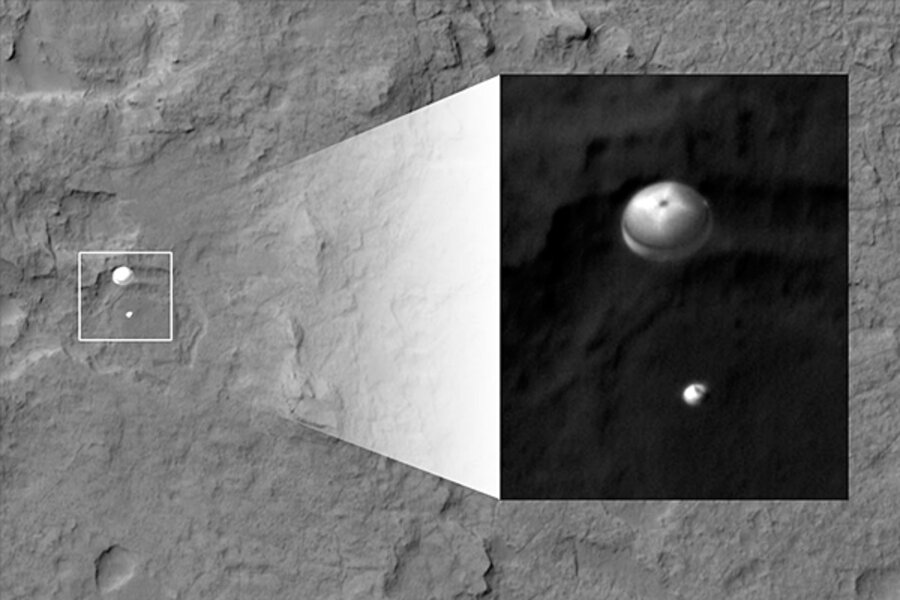A star is born: Mars rover Curiosity has legions of fans all a-Twitter
Loading...
| Washington
Meet Mars’s most charming resident: the NASA’s Rover Curiosity.
How do we know it’s charming? As the Rover Curiosity touched down on Mars early Monday morning, the Mini Cooper-sized crawler let its Twitter fans around the world follow its descent to the Red Planet with a stream of lively tweets that sought to put a human face on a scientific quest.
“I'm safely on the surface of Mars,” Curiosity said. “GALE CRATER I AM IN YOU!!!”
The images sent back from Mars – always stunning in an understated, literally otherworldly kind of way – are delivered with a smile by the cheery Curiosity.
“No photo or it didn't happen? Well lookee here, I'm casting a shadow on the ground in Mars' Gale crater,” it tweeted with this attached image.
The six-wheeled rover even shed some light on what its human friends were doing back in NASA mission control as it was working hard not to obliterate itself on Mars’s surface. That is, cracking open jars of goobers.
“Pass the Peanuts! Everyone's eating peanuts, right?” Curiosity said from millions of miles into space. “They're an [NASA Jet Propulsion Laboratory] good-luck tradition since Ranger 7 in 1964.”
OK OK, you say, Curiosity isn’t REALLY tweeting for itself. That falls to a team of three individuals hammering away at several social media accounts just a five minute walk south of NASA's Jet Propulsion Labs mission control in Pasadena, Calif.
The group has been active since Nov. 2008, when the rover was "WAY cool, nearly built" but "need[ed] a name," in the words of its first tweet. It's been a non-stop three days for the team, said news and social media manager Veronica McGregor. They've boomed from 150,000 Twitter followers on Saturday to nearly 700,000 on Monday evening.That's in exchange for the group running on a grand total of six hours sleep – combined.
But Curiosity isn’t just a one-dimensional producer of tweets. No, no – it reads, too. The rover follows a cast of physicists, astronauts (Buzz Aldrin and Mark Kelly, the husband of former Democratic Rep. Gabby Giffords of Arizona) and friends and colleagues at NASA.
But imagine, for a moment, this wanna-be Wall-E taking a break from its Mars roving to catch up with the latest tweets from the eclectic cast of notables whose tweets it follows: music impresario will.i.am, comic creator Stan Lee, “Science Guy” Bill Nye, Twitter founder Biz Stone, former Reading Rainbow host LeVar Burton, and, of course, Spock.
(Although Leonard Nimoy has found time to tweet about Gore Vidal and Michael Phelps, he has yet to wish Curiosity long life or prosperity.)
It’s not like Curiosity was the first rover to tweet – its predecessors Spirit and Opportunity (2004) and Phoenix (2008) did, too.
And Curiosity hasn’t yet tweeted the sort of world-bending science discovery generated by its earlier cousin Phoenix.
“Are you ready to celebrate? Well, get ready: We have ICE!!!!! Yes, ICE, *WATER ICE* on Mars! woot!!! Best day ever!!” gushed Phoenix on Twitter back on June 19, 2008.
But on one metric, Curiosity has its predecessors beat: followers. Its crop of Twitter subscribers way outnumbers the 160,000 for Spirit and Opportunity and some 210,000 for Phoenix.
And if Curiosity’s tweets leave you wanting more, the rover’s real-life NASA driver, Scott Maxwell, tweets for himself as well.
Via Twitter, the Monitor asked Mr. Maxwell which feed – his or the rover’s – was more of a must-have.
He replied: “Do you have to choose?”
No, we don’t – and if Curiosity is any indication, this won’t be the last highly-engaging mission to Mars.
Shortly after Curiosity touched down, another Mars mission reminded Twitter that the next trip was coming down the intergalactic pike.
“Anyone know what the next mission to #Mars will be?,” tweeted NASA’s MAVEN Mission early Monday morning. “Set to launch Nov. 18, 2013.”





